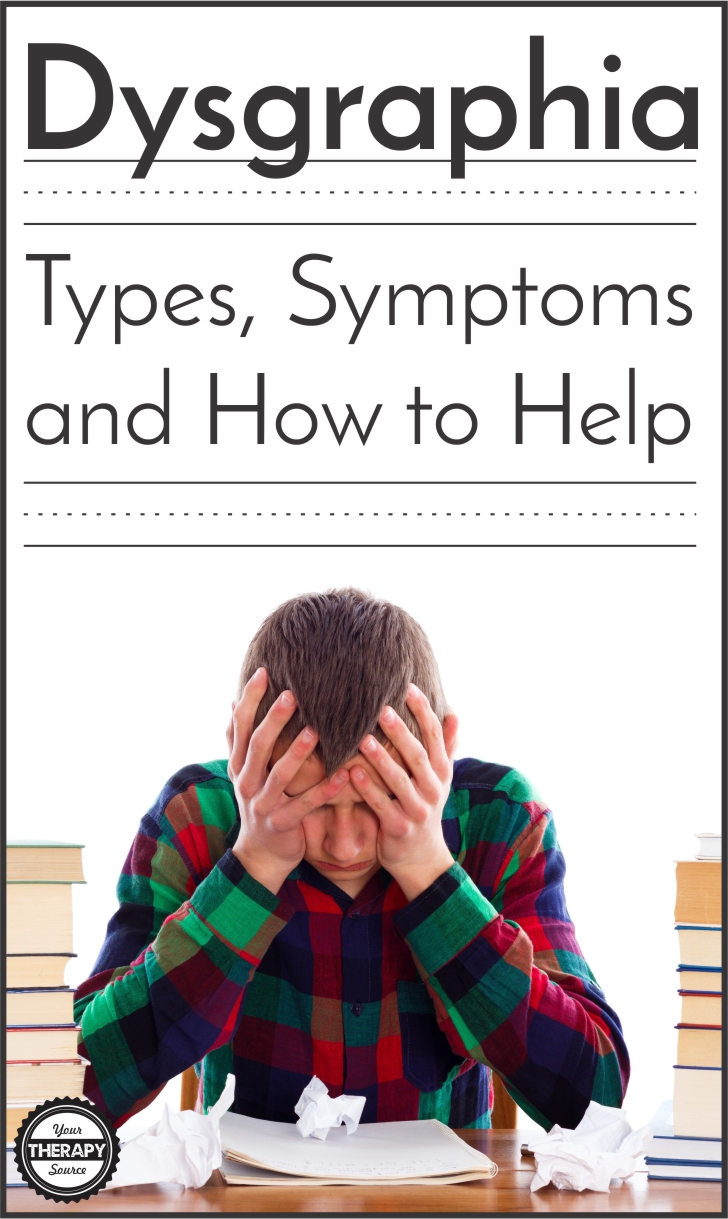Types of Dysgraphia – Symptoms and How to Help
Do you work with children who have trouble with the ability to write, regardless of their ability to read?
Perhaps you have students without cognitive impairment, who continue to struggle with written expression.
If you work with students who have ADHD or Autism Spectrum Disorder, you may encounter difficulties with written expression as well considering that a recent study indicated that 59% had dysgraphia, and 92% had a weakness in graphomotor ability relative to other abilities (Mayes et. al, 2017).
Sue Ramin-Hutchison (Certified Teacher Consultant for Physically & Otherwise Health Impaired Students, Assistive Technology Support Specialist and Special Education/Section 504 Advocate) and Merri Domer (Special Needs Technology Consultant), have compiled helpful information on the types of dysgraphia, symptoms and how to help.
What is dysgraphia?
Most individuals who have significant motor or sensory-motor handwriting challenges have a form of the neurological disorder known as Dysgraphia — with “Dys” meaning “difficulty” and “graphia” meaning “writing.”
In childhood, the disorder generally emerges when children are first introduced to writing. Dysgraphia can occur after neurological trauma or it might be diagnosed in a person with physical impairments, Tourette Syndrome, ADHD, Learning Disabilities, or an Autism Spectrum Disorder such as Asperger’s Syndrome. It is also very possible for a person to be Dysgraphic without showing evidence of any other disabilities. These individuals often have a parent or other close family member who show signs of Dysgraphia as well. The DSM IV identifies Dysgraphia as a “Disorder of Written Expression” as “writing skills (that) …are substantially below those expected given the person’s …age, measured intelligence, and age-appropriate education.”
What are the General Symptoms of Dysgraphia?
- A mixture of upper case/lower case letters
- Irregular letter sizes and shapes
- Unfinished letters
- Struggle to use writing as a communications tool
- Odd writing grip
- Many spelling mistakes (Sometimes)
- Decreased or increased speed of writing and copying
- Talks to self while writing
- General illegibility
- Reluctance or refusal to complete writing tasks
- Crying and stress (which can be created by the frustration with the task of writing and/or spelling. This can also be brought on in dysgraphic students by common environmental sources such as high levels of environmental noise and/or over-illumination).
- Experiencing physical pain in the hand and/or arm when writing
- Poor use of lines and spaces
What are the 5 Types of Dysgraphia?
There are 5 different types of dysgraphia although some children may have more than one type of Dysgraphia. Symptoms, in actuality, may vary in presentation from what is listed here.
Dyslexic Dysgraphia
With Dyslexic Dysgraphia a person’s spontaneously written work is illegible, copied work is pretty good, and spelling is bad. Finger tapping speed (a method for identifying fine motor problems) is normal. A Dyslexic Dysgraphic does not necessarily have Dyslexia. Dyslexia and Dysgraphia appear to be unrelated but often can occur together.
Motor Dysgraphia
Motor Dysgraphia is due to deficient fine motor skills, poor dexterity, poor muscle tone, and/or unspecified motor clumsiness. Generally, written work is poor to illegible, even if copied by sight from another document. Letter formation may be acceptable in very short samples of writing, but this requires extreme effort, an unreasonable amount of time to accomplish and cannot be sustained for a significant length of time. Writing is often slanted due to holding a pen or pencil incorrectly. Spelling skills are not impaired. Finger tapping speed results are below normal.
Spatial Dysgraphia
Spatial Dysgraphia is due to a defect in the understanding of space. This person has illegible spontaneously written work, illegible copied work, but normal spelling and normal finger tapping speed. Students with Spatial Dysgraphia often have trouble keeping their writing on the lines and difficulty with spacing between words.
Phonological Dysgraphia
Phonological Dysgraphia is characterized by writing and spelling disturbances in which the spelling of unfamiliar words, non-words, and phonetically irregular words is impaired. Individuals with Phonological Dysgraphia are also unable to hold phonemes in memory and blend them in their appropriate sequence to produce the target word.
Lexical Dysgraphia
Lexical Dysgraphia is evidenced when a person can spell but relies on standard sound-to-letter patterns with misspelling of irregular words. This is more common in languages such as English and French which are less phonetic than a language such as Spanish. This type of Dysgraphia is very rare in children.
Stress and Dysgraphia
There are some common problems not related to Dysgraphia but often associated with Dysgraphia – the most common of which is stress. Often children (and adults) with Dysgraphia will become extremely frustrated with the task of writing (and spelling); younger children may cry or refuse to complete written assignments. This frustration can cause the child (or adult) a great deal of stress and can lead to stress-related illnesses. This can be a result of any type of Dysgraphia.
Who can Diagnosis a Child with Dysgraphia?
While Dysgraphia can be suspected by professionals such as Occupational Therapists and School Psychologists, a Neuropsychologist is usually best to make this official diagnosis. It is not necessary to know the specific type of Dysgraphia in order to determine and implement successful solutions. Most students with Dysgraphia have a mixed form of this disorder.
Dysgraphia and the US Public School System
Dysgraphia is often very misunderstood in public schools (as well as parochial, private and homeschools) across the US as to the potential severity of its educational impact. Even when Dysgraphia has been diagnosed by an appropriate professional such as Neuropsychologist or Neurologist, the area of handwriting problems and their effective solutions are often not appropriately addressed for special needs kids in both inclusive and self-contained classrooms. It is often thought that continued handwriting practice will improve a Dysgraphic student’s ability to use paper and pencil alone as a useful tool to complete all their written schoolwork. This is rarely the case.
While Occupational Therapy and Vision Therapy can sometimes help to improve a Dysgraphic student’s letter and number formation in isolation and/or in short writing samples, this improvement is not always able to be sustained when kids are actually using their handwriting to complete their written schoolwork. The same thing is true of making kids re-do written assignments to make them more legible. In cases of Dysgraphia, “practice does not make perfect.”
Also, as these students get older and written demands continue to increase each year, it is very common for these students to often write the minimum just to “get by” and their attitude about school and themselves can be negatively impacted to a significant degree. It is not uncommon for these students who do not have appropriate “handwriting solutions” in place to eventually have emotional and behavioral challenges related to their frustration in not being able to complete finished written products similar to those of their peers. This is especially true of bright students who have so much to say and no way to communicate it adequately in writing.
How Can You Help Students with Different Types of Dysgraphia?
Sue Ramin-Hutchison is a Certified Teacher Consultant for Physically & Otherwise Health Impaired Students, Assistive Technology Support Specialist and Special Education/Section 504 Advocate and Merri Domer, a Special Needs Technology Consultant, have written a comprehensive resource guide that can help if you work with students, grades K-12, who experiences one or more of the following symptoms:
- Is falling behind with written schoolwork and cannot keep up with written assignments independently
- Has labored writing and fatigues easily when completing written schoolwork
- Experiences physical pain/hand cramping when writing
- Has written schoolwork that is often illegible/difficult to read
- Has difficulty reading what they have written
- Spends an inordinate amount of time completing class assignments
- Spends too much time after school/at night completing homework
- Has written content that does not “match” their thought content
- Shows continued frustration/avoidance behaviors/crying/stress when asked to complete written assignments
- Requires someone to write much of their written schoolwork for them (a scribe)
- Requires accommodations at school such as reduced assignments and oral answers
You can order the resource guides HERE to get started helping students with written output disorders.
References:
Domer, M. and Ramin-Hutchinson, S. What is Dysgraphia? Retrieved from the web on 2/12/18 at http://www.handwriting-solutions.com/dysgraphia.asp.
Mayes, S. D., Breaux, R. P., Calhoun, S. L., & Frye, S. S. (2017). High Prevalence of Dysgraphia in Elementary Through High School Students With ADHD and Autism. Journal of attention disorders, 1087054717720721.
Read more on dysgraphia:
Orthographic Processing and Handwriting
Evidence-Based Interventions to Help Students with Written Expression
How Can OT Help Students with Dysgraphia?
Dysgraphia Accommodations and Modifications




